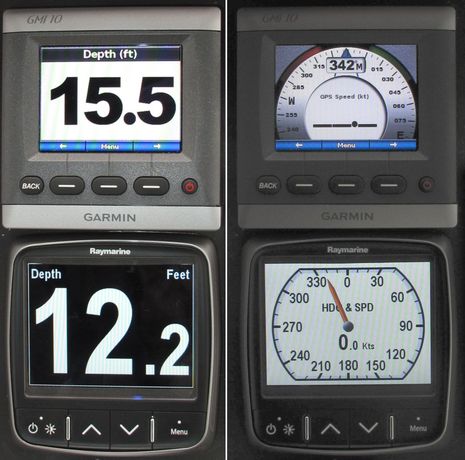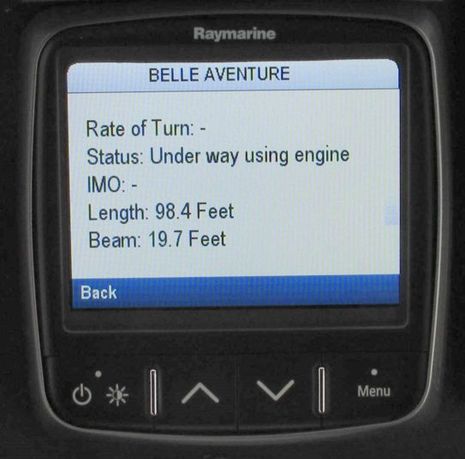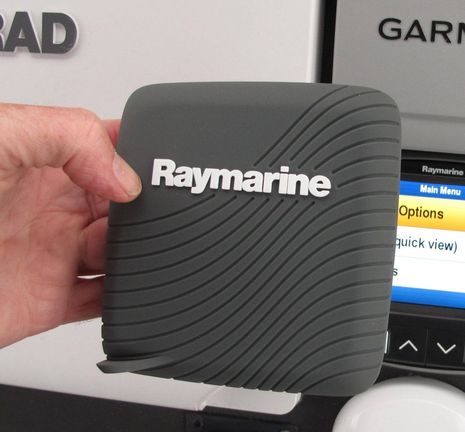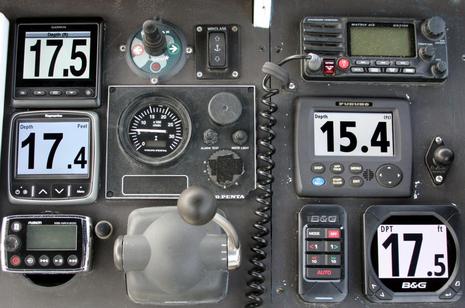Raymarine i70 vs Garmin GMI 10, mission accomplished?
A bigger and at least as bright a display? Check! Able to show vaguely as many NMEA 2000 data fields in vaguely as many ways? Check! Also manageable with a clean and intuitive interface? Check! Don’t take me too seriously as I’ve only tested the new Raymarine i70 for maybe an hour now, but it’s no doubt an impressive parry at the venerable Garmin GMI 10…
So far I’ve seen a number of things to like about the i70. Take, for instance, the sharply reduced font size on the decimal value seen in the top photo. It seems easy to see a simple, easy-on-the-brain 12 feet of Depth, or get the nuance of the 12.2. (Incidentally, the depths are different because the two instruments are on different N2K networks with different transducers). And note the nice inverse daytime Display Color, which I can’t find available on the GMI.
I also like how the first option on the display menus is Quick Options and its first option is likely the one you use the most. So when in the i70’s unique AIS plotting mode, two taps on the menu button (and no scrolling) turns on “View” targets. In that mode the up and down keys jump from target to target instead of changing display pages. A selected vessel’s name appears at the top of the plotting screen and the Menu button becomes Info…
The Info button takes you to scrolling pages detailing the target attributes, along with CPA/TCPA calculations, and one or two taps on the Back button gets you back to AIS View mode or regular instrument mode. Nice! But I do have a quibble with the info screens, which is that they show data fields with no data. Who needs to see (and scroll through) lines for the beautiful Belle Adventure’s Rate of Turn and IMO # if they aren’t being transmitted? Actually I probably wouldn’t have noticed this if I hadn’t used a Vesper Watchmate 850 all season and seen how well it can parse target details. As I’ve said before, I wish every AIS display manufacturer would take a good look at what Vesper is doing.
The i70 also has a soft protective cover that seems clever. It will stow better than traditional hard plastic covers, and won’t rattle or blow around as easily. Raymarine’s new e7 MFD has one too.
But the real test of the i70 will come as more boaters find out if it can display all the N2K they’d like, as they like. And then when Ray updates the unit to satisfy, and to reflect expansion of the N2K PGN roster. For instance, standardized alarming is supposed to be official very soon. Raymarine does not have a great track record at updating gear, while Garmin’s is awesome. Just check out all the tweaks made between GMI 10 software 2.0 and 3.5. Can Raymarine catch up in this department, and where will the B&G Triton and other color all-in-ones fit in the mix?

















Little digits should be seen and not heard [crunch].
I watch my depth and speed instruments for rate and direction of change as much as for the whole number. So the little digits can be more relevant than the big ones. This is important in trimming sails and even more important in creeping over a bar, where waiting for the next foot to decide whether to turn away can be entirely too adventurous!
Seems to me the display manufacturers are intensely focused on how bright they can make their screens. This is commendable for daylight viewing, but so far, I’m not impressed with the way night dimming is handled with the GMI 10. When looking forward over the top of the display at night the dimmed display is still too bright and kills ones night vision. With an old (ancient) Nexus display next to a new GMI 10 the Nexus has the better night colors and intensity.
Also, have any of the new displays included an ambient light sensor to automatically dim the screen as the sun sets? My Garmin 4212 chartplotter does this beautifully. How much would it cost to include this on the GMI 10 – maybe another $10 ? I would go for it!
Richard, besides changing the GMI 10 to Night Colors, have you also been turning the brightness way down? The combination works fine for me and I was happy to see that the GMI remembers the brightness setting I like for night mode. The i70 can also be set to night colors and a way low brightness level that works for me.
On reviewing a pre production i70 I agree that the instrument is a leap ahead in display and user interface. However the Garmin leads the pack on PGN coverage. The i70 I looked at could not display tank levels other than fuel (fresh water, grey water, black water missing) and temperatures (refrigeration, freezer and heating system missing). By the way, the E wide series, C wide series and new e7 can’t either.
NMEA-2000 enables monitoring and control of vessel systems way beyond just navigation. I am hopeful again that Raymarine might fully embrace NMEA-2000 PGN coverage to complete what otherwise (in my view) are excellent products.
Maybe the powers that be don’t think matters other than navigation are important to their customer base? Ben, please tell me that the production unit software has the PGN coverage that I’m looking for.
Hi
There is a hierarchy in AIS transmissions in that the most important navigational data is transmitted with a greater priority (more frequently) than the less significant information. Thus we have the name Belle Adventure and its’ status.
If you watched that screen for a minute or more, the less significant data would appear.
The “missing” IMO (aka MMSI) number is an AIS mandatory sentence. It is being transmitted but not as frequently as important navigational data such as COG, SOG and to state “if they aren’t being transmitted?” is to fail to understand the AIS system protocols. Sometimes one can get lost in the glitz of shiney electronics and not see the message from the medium
Anon, before you spout off, you really should get your facts straight. You are correct that AIS messages are transmitted at various rates, but that’s about all you got right.
The rule of thumb is that if your AIS plotter can see a target vessel’s Name, it has received all the data fields that the target is transmitting. That’s because the field “Name” is only included in the Static data message, which is only transmitted every six minutes.
Moreover, AN IMO NUMBER IS NOT THE SAME AS AN MMSI NUMBER. In fact, a vessel’s MMSI is included in all its AIS messages because that’s the key which identifies the messages as coming from the same source. Also note that Rate of Turn (ROT) is included in the Class A Position message, which also known as the dynamic data message and is transmitted frequently.
So to recap, the first AIS information that any plotter will see about Belle Adventure is her MMSI, Lat/Long, COG, SOG, Heading, and ROT. Eventually — usually a few minutes later — you’ll also see her name, dimensions, type, etc. Belle Adventure was not transmitting ROT when I took that photograph, and I very much doubt that she has an IMO number.
The best place I know to see the details of AIS messages is here:
http://www.aisparser.com/sdk/annotated.html
And IMO numbers are explained here:
http://en.wikipedia.org/wiki/IMO_ship_identification_number
Dear Ben,
hereby another great looking and performing N2K display, the Geonav MID110
http://www.geonavmarine.com/Product.aspx?id=574#next
Dealing with a lot of sentences. Perfect clear display.
Best regards,
Reinier Zwolsman
Do you know if the i70 is going to replace the ST70-series?
I’ve have a couple of ST70 and I’m planning to buy a new pilot control and one more display the upcoming spring, but now I can’t make my mind up if I need to buy them now (to get the same design) or switch to the i70 instead.
I think I saw something from Raymarine that said the i70 would replace the ST70 but I am not positive. I can tell you that the i70 fits the hole created if an ST70 is surface mounted but it might tricky to replace an ST70 that was flush mounted.
Personally I doubt I’d buy an ST70 over an i70, even if it was much less expensive and/or if the i70 caused a style mismatch.
I have been reviewing instrument set ups for my new delivery in Jan – One thing I cant get my head around is the cost of Instruments against a MFD – Am I missing something I can get pretty much all the NMEA 2K data up on a 7″ MFD with build in GPS and chart functionality and use it as an Instrument at less cost then 2-3 of these displays I need. For me I will go with a Simrad NSS 12 ,and two NSS 7 up top and add in the NMEA 2 K to that, that way I get full functionality of all functions at all positions rather then the repeated information on the Instruments. Can someone let me know if I am missing something major going this way?
I don’t think you’re missing anything “major”, Kevin. My quick survey indicates that you can get a 7-inch MFD for about the cost of three same brand color instruments. But there are some factors to consider. For one, all three instruments will need substantially less power than the MFD. For another, the data displays on the instruments are often more sophisticated than what’s available on the MFD (though that doesn’t have to be).
In the case of an NSS7 you’re also saving the cost of an autopilot control head.
I had planned to go just that route for just that reason but have now decided against it because of my (sailboat) cockpit setup. It’s dual wheel with no space to flush mount an NSS7 at each wheel. I would need to put a single one on the center cockpit table rear end. When sailing upwind, sitting on the coaming and leaning against the stern pulpit then I would be looking at a center NSS7 at a very small angle of only 10 degrees and 4 feet away vs. a 70 degree angle and one foot away with a dedicated instrument right by my tigh.
I was also told that the NSS7 does not as of now include a wind instrument with a digital needle which I kind of need to have. I was told this is scheduled for the next SW update.
Thanks Appreciate your comments – I will let you know what I decide on and how I go with the install.
Ben,
Still waiting for something other than a product brochure to show up on Raymarine’ s website – Any idea if you can create – and label – custom pages that display the same data from two separate sources, e.g., two transducers, two GPS’s, two compasses, etc.?
I can’t understand why manufacturers apparently fail to realize that a lot of vessels have more than one source for particular data, frequently the result of upgrades and retrofits. There is so much potential redundancy that goes unused, largely because there is no way to designate a given display to a given source. Garmin has all these “Auto” selections built into the GMI10 where more than one data source is detected, but try and get them to explain what the logic protocol is in Auto mode – if you can’t determine, easily and unequivocally, WHICH source you are reading from, and how the system prioritizes primary over secondary sources, what in the world is the Auto function good for?
I’m hoping Raymarine addressed this with the I70 – even though it apparently won’t read any of the 0183 devices that oftentimes form the bulk of the secondary or backup systems…
Did anyone else notice the Garmin GMI 20 advertisment in Cruising World this month? As far as I know, Garmine hasn’t yet released the GMI 20 – I certainly can find no reference to it on their web site, via Google, or – even more surprisingly – here on Panbo!
Good catch, JWS! Apparently there was a timing glitch. Look for formal announcement next Tuesday April 23rd at 7AM ET. I will try to find out all I can.